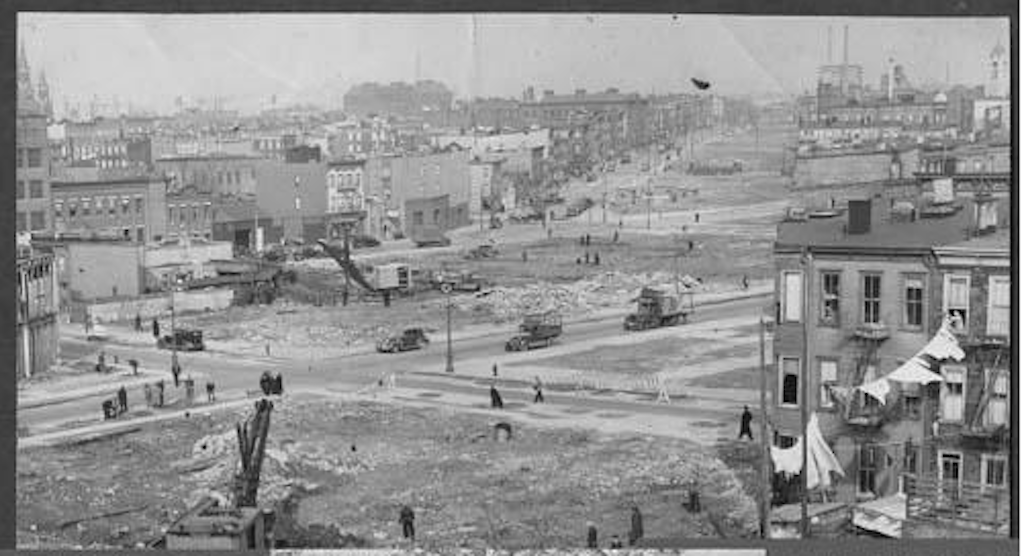Brooklyn Heights Section of Infamous BQE Slated for Major Re-Build


A major overhaul is planned for a Brooklyn Heights section of the BQE, the congested, dangerous and perpetually under construction highway that links us to Queens and numerous bridge crossings.
As first reported by The New York Times, the City’s Department of Transportation (DOT) has announced that it is planning to rebuild a 1.5 mile stretch of the Brooklyn Queens Expressway, from Atlantic Avenue to Sands Street, including the three-level, cantilevered section under the Brooklyn Heights promenade. The project will last approximately five years, and could start as early as 2020.
Over 190,000 cars and trucks use the BQE daily, the New York State legislature reported earlier this year.
The City says it will cost $1.7 billion (reportedly the DOT’s most expensive project ever) to rebuild this portion of the BQE. The highway’s structure here includes 21 concrete-and-steel bridges, running above local roads. In the three-level section, each level is apparently supported at only one end.
A recent engineering inspection has found that the Atlantic Avenue to Sands Street section of the BQE is essentially stable, but, as the Times notes, steel rebars inside the expressway’s concrete walls are corroding because of road salt seeping through cracks. “These cracks were getting wider from freezing and thawing, and moisture. Eventually the rebars will break apart, further weakening the concrete,” the Times stated.
The walls and decks of the highway will most likely require emergency repairs if not strengthened within the next decade, the City says in its inspection report.

The City has also flagged a section of the BQE at Columbia Heights, saying that the highway deck there “needs monitoring,” after its load carrying capacity was tested.
According to the Times, residents have been told that all three lanes on the BQE will remain open, in both directions, and that highway traffic will not be diverted onto local streets during construction. Part of the promenade is also supposed to remain open.
Transportation Commissioner Polly Trottenberg told the Times that she “saw the project as an opportunity to improve the safety of the expressway’s outdated design. That 1.5-mile stretch has a high crash rate, in part because of narrow lanes, no shoulders and no acceleration lanes for cars to merge into traffic.”
The City also reportedly hopes to use the reconstruction project as a way to increase pedestrian access to the waterfront. Read more about the City’s inspection and initial plans here.
Will Albany Help?
The de Blasio administration is hoping that the State will help pay for the billion dollar-plus project, but has planned for the eventuality that it will not receive assistance, the Times reported.
Led by Daniel Squadron, some of New York City’s state legislators have asked Albany to contribute $659 million toward the BQE project, a sum they say would be “consistent with what NYCDOT has said the State has traditionally funded for construction work on City-owned portions of the highway system…including the Belt Parkway over the Ocean Parkway project.”
Robert Moses Is Still With Us
One of Robert Moses’ many expressways, construction of the BQE began in the 1940s, but was not completed until 1964. The BQE stretches 11.7 miles, from the Brooklyn-Battery Tunnel near Red Hook to the Grand Central Parkway in Queens. West of Red Hook, the BQE becomes the Gowanus Expressway.
The cantilevered section of the BQE on the edge of Brooklyn Heights opened in 1954. “One of the expressway’s most distinctive features, this section was built to conserve space and minimize intrusion in the surrounding neighborhood,” the City notes in a history of the BQE. “The Brooklyn Esplanade (or Promenade) grew out of a citizens plan to mitigate the effects of the expressway.”
The idea of a promenade at this location dates back to the 1820s, the City describes. “Moses consented to building the 0.5 mile stretch of highway underneath the cantilevered canopy…opting to create a public promenade with spectacular views of lower Manhattan and many recreation and sitting areas.”
Moses had originally planned to run the BQE right through a section of Brooklyn Heights, destroying scores of homes. The neighborhood was spared this fate in the 1950s, but other neighborhoods along the BQE’s route were not as fortunate.

As is visible to all of us, New York City’s highway infrastructure is aging. The Times reports that the City DOT is responsible for 789 of the 2,000 bridges in the five boroughs. The average age of the bridges in the DOT’s care is roughly 70 years, “or about 20 years older than their intended life spans, according to city transportation officials.”




